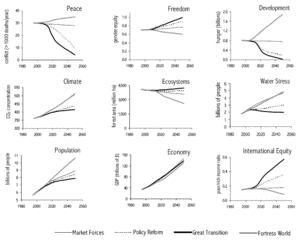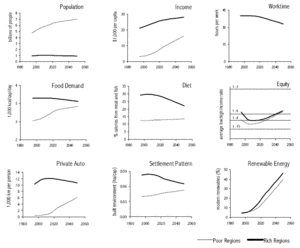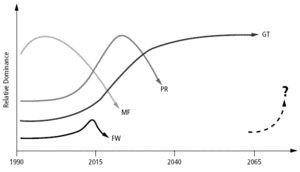Great Transition: The Shape of Transition
| Topics: |
This article is a chapter in the e-book, Great Transition: The Promise and Lure of the Times Ahead
The original publication can be found on the Great Transition Initiative website
Depending on how the uncertainties of planetary transition are resolved, the global future can branch into distinct paths. The scenarios discussed in this essay are alternative stories of the future, each representing a unique combination of institutions, values, and culture. The narratives can be further elaborated with a quantitative sketch of how key indicators unfold over time. We focus on four of the scenarios—Market Forces, Policy Reform, Fortress World and Great Transition.
All scenarios begin with the same set of contemporary trends that are now driving the world system forward. Social, economic and environmental patterns then gradually diverge as they are conditioned by different events, institutional change and value choices. Market Forces is a world of accelerating economic globalization, rapid spread of dominant institutions and values, and minimal environmental and social protection—the competitive global market shapes the planetary transition. Policy Reform features government initiatives to constrain the economy in order to attain a broad set of social and environmental goals—sustainability policy shapes the planetary transition. Fortress World envisions a period of crisis leading to an authoritarian and inequitable future—tyranny shapes the global transition. In Great Transition, a connected and engaged global citizenry advances a new development paradigm that emphasizes the quality of life, human solidarity, and a strong ecological sensibility—new values shape the planetary transition.
Global patterns are compared in Figure 11[1]. Market Forces are defined by counteracting tendencies. Technological innovation steadily reduces the environmental impact per unit of human activity, but the increase in the scale of human activity drives impacts higher. Economies in poor regions grow rapidly, but so do disparities between and within countries. The result is a continued erosion of environmental health and the persistence of poverty. Policy Reform “bends the curve” through the rapid deployment of alternative technology—eco-efficient industrial and agricultural practices, highly resource efficient equipment and renewable resources—and targeted programs to reduce poverty. Fortress World is a dualistic world of modern enclaves of affluence for the few, and underdeveloped areas of destitution for the many.
Great Transition includes the rapid penetration of environmentally benign technologies, as does Policy Reform, but at a more rapid pace. A second major feature also supports environmental sustainability—the shift toward less materially-intensive lifestyles. Resource requirements decrease as consumerism abates, populations (Population growth rate) stabilize, growth slows in affluent areas, and settlement patterns become more integrated and compact. At the same time, poverty levels drop, as equity between and within countries rapidly improves.
Great Transition patterns are shown in Figure 12 for “rich” and “poor” regions, essentially the OECD countries and the rest-of-the world, respectively. Population growth moderates in response to poverty eradication, universal education and greater gender equality. In affluent regions, income growth slows as people opt for shorter formal workweeks to devote more time—an increasingly valued resource—to cultural, civic and personal pursuits. Rapid investment and transfers to poor regions stimulates rapid growth and international equity. The affluent reduce the fraction of meat in diets for environmental, ethical and health considerations. National equity in most countries approaches the levels currently seen in European countries such as Austria and Denmark. Reliance on automobiles decreases in rich areas, as settlements become more integrated and alternative modes of transportation more prevalent. The energy transition ushers in the age of renewable energy, the materials transition radically reduces resource throughput and phases out toxic materials, and the agricultural transition brings greater reliance on ecological farming.
The Great Transition is a complex story. Just as aspects of all scenarios are simultaneously at play today, the world system will unfold as a mixed state as the various tendencies compete for dominance. One possibility for the phased emergence of a Great Transition is reflected in the three eras of the “history of the future” (Section 5 (Great Transition: The Shape of Transition)). The overlay and sequence of scenarios is illustrated in Figure 13. Market Forces dominates until its internal contradictions lead to a global crisis, as Fortress World forces surge briefly and ineffectually. Policy Reform ascends in the wake of the crisis. Eventually the Great Transition era begins as the long-brewing popular desire for fundamental change surges.
The analysis suggests that the momentum toward an unsustainable future can be reversed, but only with great difficulty. The Great Transition assumes fundamental shifts in desired lifestyles, values and technology. Yet, even under these assumptions, it takes many decades to realign human activity with a healthy environment, make poverty obsolete, and ameliorate the deep fissures that divide people. Some climate change is irrevocable, water stress will persist in many places, extinct species will not return, and lives will be lost to deprivation.
Nevertheless, a planetary transition toward a humane, just and ecological future is possible. But the curve of development must be bent twice. A radical revision of technological means begins the transition. A reconsideration of human goals completes it. This is the promise and the lure of the global future.
Notes
|
|


